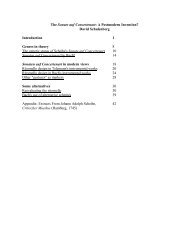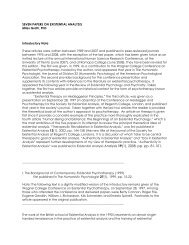download
download
download
You also want an ePaper? Increase the reach of your titles
YUMPU automatically turns print PDFs into web optimized ePapers that Google loves.
23<br />
W. 4: Sources, p. 8<br />
+) could suggest a somewhat later date. Bach would eventually use such signs routinely in<br />
instrumental parts, but in 1753 he noted that at least one sign, that for the turn, was rarely<br />
understood by those other than keyboard players. 23<br />
The missing title page might originally have been supplied by a wrapper. In its absence, it is<br />
impossible to be certain whether B1 served as a house copy, but because its text is independent<br />
of that of B2, it was more likely a sale copy that was updated by the addition of later readings<br />
from Bach's revised autograph score. It is possible that the revision of B1 came about in the same<br />
way as that described below for B2: as a correction undertaken in the Bach household of a copy<br />
whose owner, having obtained it from somewhere else, wished to have an unpdated version of<br />
the work.<br />
The keyboard part is figured throughout; the words tutti and solo appear at the beginning of<br />
respective tutti and solo passages, starting with the solo passage at i.43. The upper staff is<br />
generally blank in ritornellos, but shorter tutti passages often contain a doubling of the first violin<br />
part, and isolated notes of the first violin are also present in the upper staff at the beginnings and<br />
ends of some tutti passages. 24<br />
B2: B Bc 5887 MSM (W. 4)<br />
Five manuscript parts, one in the hand of J. H. Michel (keyboard: 30.5 x 20 cm), four in that<br />
of J. S. Borsch with additions and corrections by Michel (strings: 31 x 25.5 cm). No<br />
watermarks. 25<br />
The parts are as follows:<br />
“Cembalo”: 4 bifolios = 16 pages (the first = title page, the last blank);<br />
“Violino primo”, “Violino secondo”, “Viola”, “Basso”: each 1 bifolio (Auflagebogen) = 4<br />
pages.<br />
Original entries on the title page read: “Concerto. | Cembalo Obligato. | Violino Primo | Violino<br />
Secondo. | Viola. | e | Basso. | da C. P. E. Bach | Thema [incipit follows]”. Each part bears the<br />
title “Concerto” at the beginning of the first system.<br />
B2 is clearly described in a letter from Johanna Maria Bach (1724–95), the composer's<br />
widow, to Johann Jakob Heinrich Westphal (1756–1825), organist in Schwerin. Westphal was in<br />
the process of amassing what would become a nearly complete collection of the music of C. P. E.<br />
Bach, much of it in the form of manuscript copies obtained directly from the composer or his<br />
26<br />
heirs. Most of his collection is now preserved at B Bc; a substantial portion of it is in the hand<br />
Versuch, i.2.4.17: “man ausser dem Claviere das Zeichen des Doppelschlages eben so wenig kennet”.<br />
Ornament signs appear as follows (in the violin parts except as noted): trill, i.35, i.68, ii.33 (vn); turn, ii.26; trilled<br />
turn or prallender Doppelschlag, i.33 and 152 (va), ii.46 (v1).<br />
24<br />
E.g., in i.42 and in ii.24, where the last note f�� is the first note of the following ritornello; the next five<br />
measures of the upper staff are blank.<br />
25<br />
26<br />
Dimensions and watermark information from Leisinger / Wollny 1997, 334.<br />
Leisinger / Wollny 1997 is a catalog of the Bach holdings at B-Bc; pages 25–74 provide a detailed<br />
account of J. J. H. Westphal and his collection.















